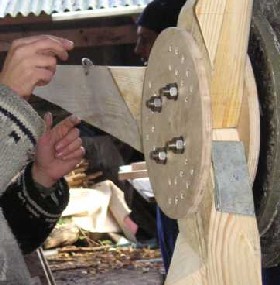A turbine is a rotary engine that extracts energy from a fluid flow. Claude Burdin coined the term from the Latin turbinis, or vortex during an 1828 engineering competition. The simplest turbines have one moving part, a rotor assembly, which is a shaft with blades attached. Moving fluid acts on the blades, or the blades react to the flow, so that they rotate and impart energy to the rotor. Early turbine examples are windmills and water wheels.
Gas, steam, and water turbines usually have a casing around the blades that focuses and controls the fluid. The casing and blades may have variable geometry that allows efficient operation for a range of fluid-flow conditions.
A device similar to a turbine but operating in reverse is a compressor or pump. The axial compressor in many gas turbine engines is a common example.
 Types of turbines
Types of turbinesAlmost all electrical power on Earth is produced with a turbine of some type. Very high efficiency turbines harness about 40% of the thermal energy, with the rest exhausted as waste heat.
Most jet engines rely on turbines to supply mechanical work from their working fluid and fuel as do all nuclear ships and power plants.
Turbines are often part of a larger machine. A Gas turbine, for example, may refer to an internal combustion machine that contains a turbine, ducts, compressor, combustor, heat-exchanger, fan and (in the case of one designed to produce electricity) an alternator. However, it must be noted that the collective machine referred to as the turbine in these cases is designed to transfer energy from a fuel to the fluid passing through such an internal combustion device as a means of propulsion, and not to transfer energy from the fluid passing through the turbine to the turbine as is the case in turbines used for electricity provision etc.
Reciprocating piston engines such as aircraft engines can use a turbine powered by their exhaust to drive an intake-air compressor, a configuration known as a turbocharger (turbine supercharger) or, colloquially, a "turbo".
Turbines can have incredible power density (with respect to volume and weight). This is because of their ability to operate at very high speeds. The Space Shuttle's main engines use turbopumps (machines consisting of a pump driven by a turbine engine) to feed the propellants (liquid oxygen and liquid hydrogen) into the engine's combustion chamber. The liquid hydrogen turbopump is slightly larger than an automobile engine (weighing approximately 700 lb) and produces nearly 70,000 hp (52.2 MW).
Turboexpanders are widely used as sources of refrigeration in industrial processes.
No comments:
Post a Comment